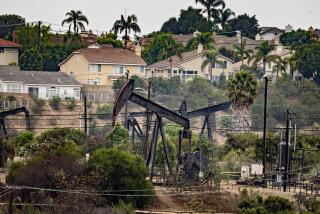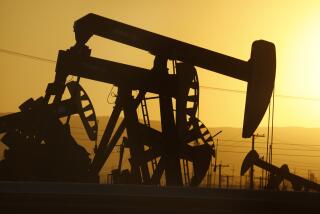Oil Debate in Alaska
- Share via
Will drilling for oil on the pristine coastal plain of the Arctic National Wildlife Refuge ease America’s energy burden? Or is it a temporary solution resulting in permanent damage to one of the most ecologically fragile areas on Earth? These are questions to be considered as President Bush develops an energy plan that includes drilling for oil in the federally protected refuge. About 95% of Alaska’s North Slope is open to drilling but not the refuge’s ecologically sensitive and oil-rich coastal plain, referred to as the “1002 Area.” When most of the refuge was given wilderness status by Congress in 1980, the 1.5-million-acre coastal plain was not included, so that oil companies could explore for oil--a section of the Alaska Lands Bill referred to as “1002.” Several energy plans are in the works, and Alaska Sen. Frank H. Murkowski (R) already released his plan, which includes drilling in the ANWR. The decision to permit exploration and development of the coastal plain can only be approved by a congressional vote. Here’s a look at the issue:
How Much Oil Is in This Strip of Land?
No one knows exactly how much oil exists in 1002, but each side of the debate over whether to drill cites figures to support its position. Though a certain amount of oil exists, it may not be economically recoverable at prices below $16 per barrel. Assuming a price of $24 per barrel, USGS provided figures based on a range of probability*. Two scenarios:
There is a 5% probability of . . .
There’s a 5% chance of finding 9.38 billion barrels of economically recoverable oil.
There is a 95% probability of . . .
There’s a 95% chance of finding 2.03 billion barrels of economically recoverable oil.
*USGS estimates in 1998, based on seismic data from 1984 and 1985 and more recent seismic surveys and drilling in adjacent areas. Current oil prices range between $25 and $35 a barrel.
Environmentalists’ Key Concern: The Caribou
Although caribou range over a large area, they prefer the coastal plain for calving because its openness protects calves from predators. It provides plenty of nutritious grasses for forage and relief from insects.
The argument
The oil industry says the caribou wouldn’t be harmed because development would only occur in winter. However, wildlife experts note that production drilling requires permanent facilities--pipelines, drill pads and roads. During calving season, caribou tend to avoid such development, and there’s little room for them on the narrow, 20- to 40-mile-wide coastal plain.
Porcupine caribou herd
The 129,000-member Porcupine herd migrates annually about 800 miles round trip, a ritual they have been following for thousands of years.
1. Late April/early May
Pregnant females numbering 40,000-50,000 begin trek from winter range. Males and juveniles follow.
2. Late May/early June
Females give birth to calves. Most years, between one-half and three-quarters of the herd’s calves are born here, most during the same week.
3. Late June/early July
Spend summer foraging, nursing their young and trying to escape thick clouds of insects. They prefer the coastal plain because snow melts there before it does in the foothills, greening up their preferred forage of highly digestible cotton grass.
4. Mid-July
Move back through mountains to fall and wintering areas.
*
Other wildlife in 1002
Polar bears
Muskoxen
Grizzly bears
Arctic foxes
Wolverines
Gray wolves
Moose
Marine life, such as walruses, seals, fish
135 bird species, including shorebirds, waterfowl and raptors
*
ANWR provides the most important land denning habitat for the Beaufort Sea polar bear population.
New Drilling Methods: More or Less Impact?
Directional wells
To minimize the effect of production on the environment, one production pad can drill several wells--up to four miles out from a surface location--and drain 64 square miles of subsurface area.
Multilateral wells
A new drilling method pioneered on the North Slope allows several new wells to be drilled under-ground from the vertical hole of a single well. Like directional wells, fewer pads means less land disturbed, oil companies say.
3-D seismic exploration
Seismic surveys use acoustic waves sent into the ground. The returning “echoes” provide data on under-ground geology. This is more precise in pinpointing oil, but environmentalists say it affects a larger area of the tundra.
The Nation’s Thirst for Oil
Where we get our oil
Crude oil as of Dec. 2000
Imported: 60% (8.9 mill. barrels/day)
Domestic: 40% (5.8 mill. barrels/day)
*
Consumption
Includes crude oil and natural gas liquids
Million barrels/day 1984: 15.7
2000: 19.5
*
Alaska production has been falling.
Domestic oil production is decreasing...
...while foreign imports are increasing.
Figures through 2000
When would the first oil flow?
If Congress approves drilling in the ANWR, oil would not be produced for about 10 years. Here’s how oil develop-ment might progress after approval:
Environmental impact studies, public comment (1.5 to 2 years)
Federal lease sales (6 months)
Seismic testing, exploratory wells drilled (2-3 years)
Evaluation of tests, construction of production facilities and pipelines (3-4 years)
Oil extracted, transported to Valdez for shipment
*
Researched by JULIE SHEER and MATT MOODY / Los Angeles Times
*
Sources: Alaska Department of Natural Resources, Division of Oil and Gas; U.S. Minerals Management Service; U.S. Geological Survey; Petroleum News Alaska; U.S. Dept. of the Interior, Bureau of Land Management; Mapmakers Alaska; Alaska Dept. of Environmental Conservation; American Petroleum Institute; BP Amoco; Defenders of Wildlife; National Resources Defense Council; Sierra Club; U.S. Dept. of Energy; U.S Fish and Wildlife Service
More to Read
Sign up for Essential California
The most important California stories and recommendations in your inbox every morning.
You may occasionally receive promotional content from the Los Angeles Times.










